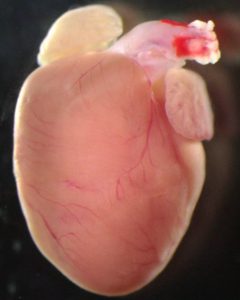Congenital heart defects caused by problems with placenta
Posted by Laura Hankins, on 28 November 2024
Brief summary: Congenital heart defects are the most common human birth defect, affecting around 1% of newborns. People with heart defects often show low levels of a protein that helps transport a key metabolite, citric acid, in their cells. Now, researchers in China have shown that although this protein does not directly affect heart development in mice, its loss causes problems with placental growth, leading indirectly to heart defects. The researchers also suggest potential treatments.

Press release: Congenital heart defects are the most common form of human birth defect, but we still don’t fully understand what causes them. Previous research had suggested that some heart defects could be triggered by problems with the placenta, the organ that provides oxygen and nutrients to the developing embryo. Now, researchers at Nanjing University, China have confirmed this link by focusing on a protein whose levels are reduced in many patients with congenital heart defects, called SLC25A1. SLC25A1 plays a key role in transporting citric acid, an important metabolite whose derivatives can affect gene expression, to different regions of our cells. However, it was unclear how the protein’s loss might be linked to congenital heart defects. By disrupting this protein in different tissues in developing mice, the researchers have shown that loss of SLC25A1 does not affect the developing heart directly. Instead, it leads to problems with placental growth and this, in turn, causes heart defects in the mice. The researchers publish their study in the journal Development on 26 November 2024.
The researchers used gene editing tools to produce mouse embryos that completely lack the SLC25A1 protein. As expected, these embryos developed heart defects. However, they also had problems with their placentas, which were thinner than usual. “A rapidly increasing number of studies in mice have suggested that the placenta is involved in the regulation of embryonic heart development,” explained Professor Zhongzhou Yang from Nanjing University Medical School, whose research group carried out the study. “However, the molecular basis of this relationship was unclear.”
The research team wanted to explore this potential relationship between placental defects and heart defects. To identify where in the embryo the protein is needed, they decided to remove SLC25A1 from specific tissues, rather than just disrupting it across the whole embryo. First, they made mouse embryos that lacked the SLC25A1 protein only in their developing heart. Surprisingly, these mice did not develop heart defects, suggesting that SLC25A1 is not playing an important role in heart cells. In contrast, when the researchers generated mice that lacked the SLC25A1 protein only in their placental tissue, they found that the mice developed both placental defects and heart defects. This suggested that SLC25A1 plays a key role in development of the placenta and, if placental development goes wrong, heart defects can occur as a result. Indeed, measurements showed that loss of SLC25A1 alters the citric acid balance in placental cells, resulting in changes to the cells’ DNA that disrupt placental development.
The researchers next explored how these changes to the placenta might cause problems with heart development. They found that the placentas lacking SLC25A1 had low levels of PSG1, a protein that is produced by the placental cells and is known to help regulate development of endothelia (sheets of cells that line the insides of certain structures in the body, including blood vessels). “We showed that administration of human PSG1 to pregnant mice improves placental and heart defects in embryos lacking SLC25A1,” Professor Yang explains. “PSG1 might therefore become a potentially effective drug to help improve placental and heart development of the foetus in the uterus.” While further work is needed, these findings could lead to the development of a new treatment strategy to prevent congenital heart defects in foetuses that are exhibiting placental problems.
Fan, W., Li, Z., He, X., Wang, X., Sun, M., Yang, Z. (2024). SLC25A1 regulates placental development to ensure embryonic heart morphogenesis. Development, 151, dev204290. doi: 10.1242/dev.204290


 (No Ratings Yet)
(No Ratings Yet)